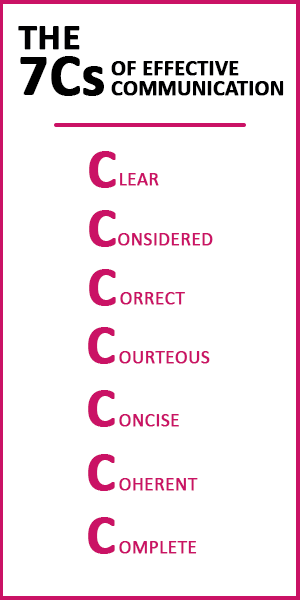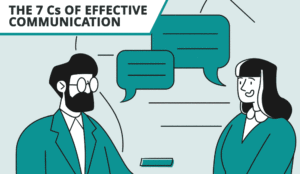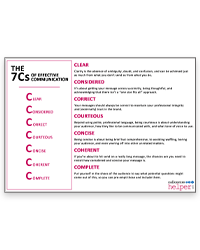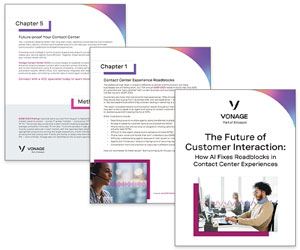Our Editor, Megan Jones, interviewed Danny Wareham, Certified Business Psychologist and coach, to find out what the 7 Cs of effective communication are and how best to apply them in your contact centre.
1. Clear
Clarity is the absence of ambiguity, doubt, and confusion, and can be achieved just as much by what you don’t send as by what you do.
Long-term success comes from governance and having a vetting process in place to reduce the sheer volume of messages going out to your colleagues and customers.
A good way to regain control over this is to ask these checking questions of each proposed communication:
- What do you need the receiver to do differently after the communication has landed?
- Is it going to the right audience?
- And most importantly of all… Does it even need to be sent?
After all, when there’s too much noise, nothing is clear to anyone!
2. Considered
Pure and simply, this one comes down to “what’s in it for me?” and delivering a tailored message to the receiver. It’s about getting your message across succinctly, being thoughtful, and acknowledging that there isn’t a “one size fits all” approach.
It’s about getting your message across succinctly, being thoughtful, and acknowledging that there isn’t a “one size fits all” approach.
As you’ve probably experienced, when this is done poorly, a blanket message will be sent to everyone, leaving most receivers confused about what it means for them and their team.
By contrast, a considered message will explain specifically how it’s going to affect YOU in your job role and team.
And yes, this may involve a bit more work, for example, sending 3 separate emails to 3 separate teams to make a core message more relevant to them, but it’s absolutely worth it to deliver a more considered message.
The same applies to customers. Don’t overwhelm them with lots of messages that aren’t relevant to them. You don’t need to tell them everything – just the bits that are important to them.
Ironically, we tend to pay a lot more attention to our external communications to customers, breaking them into segments and tailoring communications to their different needs. Wouldn’t it be great if this same level of attention was applied across your internal communications too?
3. Correct
Your messages should always be correct to maintain your professional integrity and (externally) trust in the brand, and there are two parts of this to consider:
Is the Information Correct?
This is about the content of the message itself. For example (internally) is the new commission framework for your outbound sales team correct, or (externally) are the new pricing bands for customers correct?
You don’t want to make any mistakes, especially as confusing or misleading information will very likely generate avoidable calls into the contact centre (which is the last thing anyone needs).
Is Everything Spelt Correctly?
Not only that, but your messages should also be grammatically correct and spell-checked, as a typo or missing apostrophe can undermine even the most well-considered message. After all, you might never get a complaint, but you could lose a customer!
Top Tip – Be careful with how you choose to manage this process, as introducing too many sign-off processes can slow everything down.
4. Courteous
Beyond using polite, professional language, being courteous is about understanding your audience, how they like to be communicated with, and what tone of voice to use – without compromising your brand guidelines.
It’s also good to be aware that written words can be misinterpreted, or even feel rude or dismissive, and this is more likely to happen when leaders are under pressure and hitting send too quickly.
So be conscious of this, and ask a colleague to have a quick read through if there’s anything you’re unsure about.
For a run-down of the courtesy words that you can use, read our article: The Best Courtesy Words and Expressions to Use in Customer Service
5. Concise
When you’re not concise, you risk waffling, boring your audience, and even veering off into other unrelated matters that only add to the confusion.
Being concise is about being brief but comprehensive and, unfortunately, doesn’t come naturally to a lot of people.
Why does it matter so much? When you’re not concise, you risk waffling, boring your audience, and even veering off into other unrelated matters that only add to the confusion.
Not only that, but when messages don’t have a concise point, it’s also harder to check what’s been absorbed by your audience and if further communications are needed.
So how do you make sure your messages are concise?
This comes down to having a purpose – typically one of the following:
Inform
When sending a message to inform, the sender should always ask, “what do I need the receiver to know after they’ve read this communication?”.
For internal communications, this might be a process or target change, or an update to let everyone know that systems are going to be temporarily unavailable for routine maintenance.
For customers, this might be pricing updates, or where to go to get details about a new product.

typically needs to have one of these purposes
Energize
When sending a message to energize, the sender should always focus on how they want the receiver to feel after they’ve received the message.
It helps to think of this as a trailer for a film. It doesn’t give you any information that will spoil the story and it doesn’t really tell you anything that you’ll need to recall later, but you just need to feel a certain way (hopefully excitement) about going to watch the film.
You tend to see these types of messages more often in external communications, as we all want our customers to feel a certain way about our products and services.
But you are missing a trick if you aren’t doing this internally, because your agents are people too, and it can only help to engage them as much as possible with your products and services!
Appreciate
This is about praise and recognition.
For example, praising a project team for their hard work, or thanking customers for taking part in a recent feedback survey or product trial.
Split Out the Purpose Into Different Messages
The secret to success is splitting out the purpose into different messages – even on different platforms.
For example, if you have a change in the contact centre, you may very well default to a mass email to tell everyone how they should feel about it: “Great news! Our WFM system is being updated very soon…” then something that they need to do: “Make sure you save your password” and then an appreciation message of “thank you for all the hard work that the project team put into this.”
This type of blended message can become lengthy and leave receivers confused about the key takeaway.
Is it only to log in differently next time (inform), is it that they should be excited about the update (energize), or is it that they should congratulate the project team (appreciate)?
The message could be far more concise if it was split out into targeted messages – particularly if the praise for the project team was shared elsewhere, such as on a dedicated Slack channel, or in a 1-to-1 meeting.

6. Coherent
It’s easy to slip into bad habits of jumping between points and confusing your audience.
Remember, you aren’t Billy Connolly and you need your message to be conveyed as simply as possible.
A good tell on this is length! If you’re about to hit send on a really long message, the chances are you need to revisit how considered and concise your message is.
If it’s going to ramble all over the place, it’s probably better to break it into separate and more relevant key messages for difference audiences.
7. Complete
This comes back to the audience. Do they have everything that they need? Or does your message generate more questions than it answers?
Put yourself in the shoes of the audience to see what potential questions might come out of your message, so you can pre-empt those and include the answers.
And is there an ideal word count for a complete message? Ideally, it needs to be short, succinct, and coherent enough to get the message across, but long enough to make sure the message has been received completely.
There’s not really a sweet spot. The most important thing is that it is written with the audience in mind. People are more likely to engage with it – regardless of length – if it’s written with them in mind.
From an external communications point of view, you don’t want to put out a message that generates a wave of additional calls and questions into the contact centre either!
Master the 7 Cs of Effective Communication

Wareham
Now you know the 7 Cs of effective communication, it’s time to start practising them – one message at a time. Of course, you won’t see your engagement levels magically transform overnight.
However, slowly but surely, you’ll break down the wall of noise, and your colleagues and customers alike will begin to engage and better understand the messages you’re sending them.
Good luck!
Free Download – The 7 Cs of Effective Communication
For those of you who want to share this with your team, we have put together a free download of the 7 Cs of effective communication. Simply download your copy now:
With thanks to Danny Wareham, Certified Business Psychologist and coach, for contributing to this article.
If you are looking for more advice on improving your contact centre communication, read these articles next:
- 7 Clever Ways to Improve Internal Communication Between Departments
- How to Improve Internal Communication in the Contact Centre
- A Simple Way to Improve Communication in the Contact Centre
Author: Megan Jones
Reviewed by: Xander Freeman
Published On: 19th Jun 2024 - Last modified: 14th Aug 2025
Read more about - Skills, Communication Skills, Customer Service, Danny Wareham, Editor's Picks, Free Downloads, Leadership, Skill Development, Top Story, Training and Coaching






















